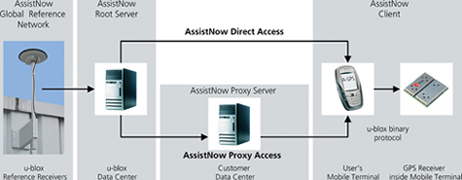
You are lost in a narrow street in Bangkok, trying to decipher street signs in Thai characters. You need to get back to your hotel, grab your bags and head to the airport fast or you will miss your flight.
You try using the personal navigator on your PDA but the regular GPS receiver inside cannot establish a position because signal conditions are bad due to high-rise buildings all around you. You know it normally takes your GPS receiver at least 30 seconds to pinpoint your location. However, under the adverse signal conditions you are facing (due to tall buildings blocking the view to satellites), your receiver could take minutes to locate you, or even fail to do so altogether. Waiting for acquisition may not be a problem for a commuter with time to waste, but sometimes you simply cannot afford to wait. That is where assisted GPS comes in.
Assisted GPS, or A-GPS, is a service that enables immediate positioning on demand, 24/7. It uses mobile phone networks to access assistance data, which consists of satellite constellation (also known as Almanac), precise satellite position (called Ephemeris) and time data. The instant availability of this data enables the receiver to compute a position fix within seconds.
A typical A-GPS framework, such as the one in Figure 1, consists of a global reference network of GPS receivers deployed worldwide, a server that collects and transmits the assistance data, and one or more user terminals. The GPS receivers that form the global reference network collect satellite location data, known as Ephemeris. A dedicated server receives the data from the global reference network and transmits it to the user terminal(s) upon request, slashing TTFF down to seconds.

Assisted GPS services enable applications that provide on the go, accurate and reliable location information with minimal maintenance. The range of applications that require, or greatly benefit from, instant positioning is very broad. From enhanced personal navigation services that can be consulted on the fly - from a PDA or a mobile phone for instance - to complex, multi-user/terminal management systems, the ability to provide instant location information has significantly widened the spectrum of GPS-enabled applications.

In the past two years, GPS receivers have been making their way into mass-market portable devices thanks to ever-shrinking GPS receiver sizes, costs and power needs. A-GPS can now be offered to a much broader public and the provision of instant-positioning services is soon to become the next 'must-have' feature for leisure and professional GPS-enabled devices.
For example, mobile phones are increasingly offering emergency caller services that enable the immediate location of the caller, useful in cases of medical emergencies, fires, break-ins and other events where it is difficult or impossible for a person to communicate his/her location. When testing product prototypes in design-in projects, engineers using A-GPS will benefit from being able to immediately test their applications without having to wait for normal acquisition to occur. A-GPS can also be used to manage a global fleet of vans or trucks remotely, for instance. A small to medium-sized company may wish to receive reliable data easily without having to worry about the IT setup or about server maintenance. In this case, the (root) server providing the data resides on the A-GPS provider's premises, which charges a fee for the service. When the fleet (or installed base of user terminals) is large, one may wish to host a proxy server on one's own premises, to retain control of the server, to reduce latency in the communication between server and user terminals, as well as to maintain all privacy on data contained within the system. Either solution, whether root or proxy server-based, provide accurate location information of system terminals, enabling a much more efficient management of staff, goods or vehicles.
u-blox, a GPS module market leader, is pioneering this revolutionary provision of an end-to-end product-service package. u-blox' assisted GPS framework, dubbed AssistNow (www.u-blox.com/technology/assistnow), enables instant positioning, even under difficult conditions. The product-service package consists of all the necessary hardware and software and has already been implemented for a number of customers worldwide.
A network of u-blox GPS receivers deployed globally (called 'AssistNow Global Reference Network') receives the assistance data from the satellites and transmits it to any number of user terminals, upon request. All one needs is a wireless network connection that supports TCP/IP to enable the data flow between the user terminal(s) and the server providing the data. A connection can be established using any wireless and cellular network like GSM/GPRS, CDMA or UMTS making use of User Plane communication. u-blox provides the server, the GPS receiver(s) in the user terminal(s) and reliable assistance data collected by the u-blox Global Reference Network. This makes u-blox' AssistNow framework a complete, no-frills, fully scalable instant positioning solution for any company, regardless of size.
| Tel: | +27 21 555 8400 |
| Email: | [email protected] |
| www: | www.rfdesign.co.za |
| Articles: | More information and articles about RF Design |

© Technews Publishing (Pty) Ltd | All Rights Reserved